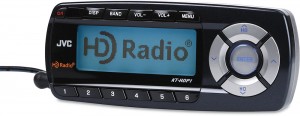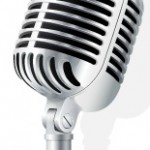Could HD Radio Be Good For Satellite Radio?
 I know that after the recent FCC fiasco regarding HD Radio, most people would have a gut reaction that it would be bad for Sirius XM. For some reason, this was not my gut reaction at all. It all started when I read a news article regarding increased HD penetration at the OEM level.
I know that after the recent FCC fiasco regarding HD Radio, most people would have a gut reaction that it would be bad for Sirius XM. For some reason, this was not my gut reaction at all. It all started when I read a news article regarding increased HD penetration at the OEM level.
As I’ve written time and time again, HD Radio is not High Definition radio but is in fact Hybrid Digital radio. Although according to iBiquity, the name “HD Radio” is simply the company’s brand for its digital radio technology, and does not stand for “Hybrid Digital” or “High Definition” as commonly believed. Regardless, the difference is clear. Literally!
Let’s assume for a moment that HD Radio achieves 100% penetration in the OEM channels. Who will suffer the most? The answer is actually not Sirius XM but rather terrestrial radio and those stations that have not made the changeover to the digital format. Once people listen to radio in a digital format it will be just as impossible to return to standard AM/FM broadcasts as it is now for subscribers of Satellite radio. It would be like returning to rabbit ears on a television.
Taking it a step further, as more and more people realize the superior sound quality of digital broadcasting, the more likely it becomes that many would opt for the Satellite version without the constant commercials that plague terrestrial radio today, the superior content and the end of signal drops as a result of being out of range.
Problems continue to plague HD Radio and the infrastructure is not where it needs to be to make it a viable service, offering still another reason to suggest that Sirius XM will be the beneficiary of this now rushed to market product.
iBiquity Digital claims that the system approaches CD quality sound and offers reduction of both interference and static; however, some listeners have complained of increased interference on the AM band. WYSL owner Bob Savage, arguably the most vocal opponent of HD Radio technology on the AM band, filed a complaint against WBZ in Boston. WBZ (a 50,000 watt station on the 1030 kHz frequency), Savage alleges, was causing interference to Savage’s 500 watt night signal at 1040 kHz.
When the complaints start rolling into the dealership service departments, surely one suggestion from service advisers will be to switch to Satellite Radio. Ironically, the end of terrestrial radio may come at the hand of terrestrial radio itself.
Position: Long SIRI





That is why I said that if push came to shove during the merger process, HD would have been an easy concession to accept.
https://siriusbuzz.com/the-deal-with-hd.php
I would hate to think that satrad was the consolation prize because HD could not deliver. HD has problems all of its own. Compared to the greater number of AM-FM stations there are only a relatively small number of HD stations at this time. Broadcasters are not 100% sold on the idea because of cost and its small penetration in the marketplace. The sound may be better, but it’s still the same old programming with all of the commercials. We’ll see Ipod connections standard on all vehicles before we see HD radio standard equipment. Satrad goes beyond just sound quality in that it’s commercial free music and also in its content available anywhere in the US. Car sales will come back before too long and satrad penetration will skyrocket. It’s just that the merger happened the middle of the worst recession in thirty years. Give it a little time.
HD Radio simply doesn’t work, as Pioneer can attest, and would have simply driven up the cost of Satrad receivers, with inferior performance:
“Pioneer says HD Radio succcess should be decided by open market, not forced inclusion”
“IBiquity, the company behind HD Radio, is making enemies all over the place, the latest of which is Pioneer. The Japan-based corp, which makes the popular Inno, recently told the FCC [PDF] that iBiquity’s scheme to force satellite radio manufacturers to include HD Radio playback is absurd. The iBiquity conditions would limit the breadth of radio product offerings to consumers, limit which radio component suppliers’ products be designed into radios, have the effect of decreasing AM/FM tuning performance, unnecessarily increase costs to consumers uninterested in HD Radio and interfere with the useful and healthy free market mechanisms extant in radio electronics purchases.”
http://tinyurl.com/5f9q2b
“Rushed to market” is how I described the ‘carny shill’ jammer known as HD Radio three years ago to the National Radio Club, whose moderator promptly suspended me from posting for one week until I could post ‘in a civil manner’.
I was intrigued. What I say? What he care? He claimed broadcasters ‘worked too incredibly hard’ on HD – that old 90s chestnut again – to be insulted by my bilious putrid invective.
I told him, at the then overripe old age of 51, a week’s suspension wasn’t likely to cure my incorrigible proclivities. I counteroffered. No suspension, instead banishment for life. I said if he didn’t banish me and stuck to his one week suspension, I’d never post again, ever.
He didn’t get it. Nor does the HD gang which promotes America’s first State Sponsored Jammer. The slightest criticism of HD provokes overblown reactive denials, lies, and irrational retaliation. Why?
What are they hiding? That fact HD was ‘rushed to market’ in hinky 90s style? The fact it’s long obsolete and serially superseded by finer delivery methods?
The fact it jams adjacent stations and renders billions of radios worth trillions of dollars worthless?
The fact HD is not only not backward-compatible but backward destructive as well?
The fact, listeners never requested HD in the first place, that HD was a contrivance by BigRadio to create a monopoly, as assisted by a crony-capitalist-friendly FCC, and that liseners aren’t fooled by this ‘high stakes corporate scam’?
The fact HD denies listener choice by jamming stations, notwithstanding smarmy denials on part of iNiquity and BigRadio shill parrots?
The fact this ‘rushed to market’ Radio-Kelvinator jammmed AM night listening to ruination and cleverly masked FM stations, further reducing choices, all the while disingenuously claiming to ‘save radio’ by providing more choices?
AM and FM sound quite fine on good quality receivers which can be had for modest cost. Digital is overrated hype, fatiguing in the long run, of no interest to anyone save for BigCorpseorate vampires whose goal is to suck every last penny from the once robust radio industry prior to scuttling it.
Paul Vincent Zecchino
Manasota Key, Florida
20 August, 2008
Whats going on with Jim Cramer? You know, after reading an article on Seeking Alpha defending Jim Cramer as not being responsible for Sirius’s stock price, I was beginning to lighten up on the bald munchkin. I really don’t feel anymore that he is responsible, and he did rally the FCC to approve the damn merger.
HOWEVER….why can’t he leave well enough alone? He has come out with 3 seperate videos in as many days bashing the common stock. Each time mentioning the death threat against him. One can’t help but wonder if he is using this as an excuse to continue trashing the stock publicly.
He keeps on saying it’s going to a buck because the bond holders are in control and there is still more debt to refinance in February that they’ll have to refinance again with even MORE dillution. Plus he says the next two quarters are going to be ugly.
All these things Brandon has argued against. And I agree with Brandon. But it still makes me nervous. After all, the market listened to the negative downgrades of Goldman Sachs and didn’t even pay attention to the positive $6.50 price target of Citi. When it comes to the optimists like myself, Brandon and Tyler of Sirius Buzz, or institutions like Citi….we always seem to be COMPLETELY ignored in favor of the bashing, negative downgrades of the Cramers and the Goldman Sach’s of the world. Why is that????
The biggest technical issues with HD radio in the U.S. are the (relative) low sensitivity of HD radio receivers, and the small amounts of bandwidth and power stations allot for their digital channels. As in the case of satrad, the FCC screwed the pooch in allowing iBiquity to retain proprietary rights over the technology, for the U.S. version of HD radio isn’t compatible with other digital audio technologies, e.g.; AAC. Newer generation HD radio head units have addressed the sensitivity issues.
As a system operator, adding HD radio would be a plus for Sirius XM because carriage of the additional local channels adds value to the basic service. In fact, Sirius could market their head units’ superior reception of HD radio channels over standard, ‘free-to-air’ radios. It’s also possible Sirius could market content back to terrestrial broadcasters to use on HD-only channels, and realize yet another revenue stream.
Two things to realize is HD radio, like satrad, is here for keeps and, we’re going to see more car manufacturers offering HD radio head units as original equipment in the immediate future. The smart move for Sirius is to act like the monopoly it is and co-op the technology for its own purposes.
You said:
“Once people listen to radio in a digital format it will be just as impossible to return to standard AM/FM broadcasts as it is now for subscribers of Satellite radio. It would be like returning to rabbit ears on a television.”
Don’t think so, good analog AM and FM sounds great, my Meduci AMX-2000 wideband stereo AM tuner sounds like an FM radio only smoother, (no connection, just a satisfied customer), digital sound is convenient and easy to work with but for anyone who has good ears it is not as pleasant sounding as analog sound, which could be part of the reason that LP’s are enjoying a huge resurgence right now while CD sales are dropping like a lead balloon.
Speaking of lead balloons, IBOC is dead as a door nail and no one is going to get anything from it except maybe a little extra business at the land fills and yard sales over the next few years and that will be very little business as very few of them have sold. Most people think 500,000 total is a very optimistic sales figure and ibiquity will not release any sales figures, Gee, I wonder why?
Strew-Bull loves to shout about how wonderful HD is and how it will be in everything from refrigerators to garbage disposals (where it belongs), but sure isn’t releasing the dismal sales figures for HD which by the way stands for Highly Dead, they dropped Hybrid Digital a few years ago once they thought they had brainwashed enough people into thinking that it stood for High Definition which it certainly doesn’t. And it definitely was not the answer to Satellite, you guys are very lucky the FCC didn’t saddle the receivers with this junk technology, would have been more expensive and would have been like a 5th wheel on a car and would have discouraged sales, an 8 track player would have been more useful. I guess even this obtuse FCC knows a dud when it sees one.
Bob Young
Millbury, MA
The cost of adding HD radio to satellite radios was then and is now a bad idea. The fact is, it is never a good business plan to add a competitor to your product, unless the company doing the adding is getting something from the deal that makes up for that cost. From your article Brandon, The only thing SIRIXM gets is a bad product. I am sorry that just doesn’t cut it. Hell GM and Toyota dont even want to do it, unless they get something from the deal and they dont even compete with HD radio.
Newman, You were wrong then and are wrong now. Adding as we now know (Even Tate said in her statement that, from what she found out to be true that the cost was not the 12 dollars that HD said it was. that it was actually at least 2 or 3 times that amount.) at least 24 to 36 dollars to SAC would not have been a easy concession to take and why Mel did not take it.
I’ll tell you what when I see the cell phone companies stop fighting small things like being able to just keep your same number if you switch services. At the vary least be willing to make cell phones capable of being able to be switched to another service instead of having to buying a new one when you switch. Then I will say kum-by-ya, cant we all just get along, and ebony and ivory.
MIB Says:
“Two things to realize is HD radio, like satrad, is here for keeps and, we’re going to see more car manufacturers offering HD radio head units as original equipment in the immediate future.”
Where’s proof of that – only Ford-owned Volvo and BMW offer HD Radio as standard, the rest are just optional. Don’t expect HD Radio to be put in-dash en-masse without the same synergies as Satrad pays:
“U.S. automakers not jumping into HD Radio” April 2007
“The radios are estimated to cost about $45 each to install, or each of the three carmakers about $150 million to $200 million annually, automotive industry sources said.”
http://www.reuters.com/article.....0220070427
It is still up to the marketplace to determine the fate of HD Radio, and HD radios are not selling – there is zero consumer interest, and no demand for automakers to offer it. Most of the models which offer HD Radio are doing poorly (SUVs, Jaguar, Volvo), and automakers are offering HD Radio just for the free publicity:
“DEAD AIR: Radio’s Great Leap Forward stalling in the Valley”
“Nearly two years after the Valley’s four Clear Channel stations went HD, several high-end car manufacturers have promised to offer HD radios as an option on new models. But while Ford announced in September that it offers the radios as dealer-installed upgrades — as have Mini, Volvo, Jaguar and BMW — local Ford and Lincoln dealers had not heard of HD and said they don’t offer the option.”
“Are Ford and HD Radio in Sync?”
“The radio industry will, of course, promote Ford for free in exchange for this development as part of the presumably soon-to-expire pledge of airtime to the HD radio effort.”
Besides, HD Radio simply doesn’t work, and it will be interesting when consumers start complaining to automakers about the poor coverage, interference, dropouts, and bland HD channel programming.
john said: Newman, You were wrong then and are wrong now. Adding as we now know (Even Tate said in her statement that, from what she found out to be true that the cost was not the 12 dollars that HD said it was. that it was actually at least 2 or 3 times that amount.) at least 24 to 36 dollars to SAC would not have been a easy concession to take and why Mel did not take it.
John, you are misquoting me here just like you did when the original article was first published.
In my article, I clearly wrote that HD would not be a bad concession AS LONG AS IBIQUITY COVERED ALL ADDITIONAL COSTS. Which would mean a grand total of $0.00 passed on to customers OR SIRI shareholders. Reread the article and grab a pair of reading glasses, because you have a habbit of pulling out the tidbits you want to fight about without taking the entire article into context, just like you are doing here.
Newman said:
“In my article, I clearly wrote that HD would not be a bad concession AS LONG AS IBIQUITY COVERED ALL ADDITIONAL COSTS.”
It would have been a bad idea to add this to Satellite even if ibquity had paid people to take them off Satellite’s hands, HD is an abomination and anything that is associated with it will also go down in flames. In plain English, HD sucks, doesn’t work and is a huge scam. Why do you think it’s not selling and they were trying to force it into your receivers? It’s junk and salesmen know it, engineers know it, most radio people that are involved know it, wake up and smell the skunk in the garden.
Bob Young
Millbury, MA
Bob, that is exactly right. It is junk. Which means if you put it in with SatRad, they REALIZE that it is junk and listen to SatRad instead.
See why it would not affect SatRad much?
PocketRadio,
Along with BMW, Ford, and Volvo, Volkswagen, Hyundai, Mercedes-Benz and Porsche have announced offering HD radio on some or all their models in 2009. That and the fact Ford and Visteon are two of iBiquity’s major backers should be an excellent indication for the direction of HD radio technology. Now if Sirius really considers terrestrial broadcasters competition (even though they have many agreements in place with terrestrial broadcast networks!), it would make for sound business to adopt some number of HD radio channels.
As Michael Corleone remarked, ‘Keep your friends close and your enemies closer’.
Newman, we have gone over this already. There are always going to be extra cost. In the example I gave to you, is that if a satellite radio sells now between 10 and 200 dollars what is the added cost when you add HD to the mix. SIRIXM is selling one radio for 8.88 they are obviously welling to lose more money on that radio to get the subscribtion. SIRI gives rebates to get the cost down what happens when you put HD in the mix. In the end if SIRI wants to keep the cost down then they are going to have to cover the extra cost of HD also. I will give you a clear example so even you can understand. There is a SIRI radio in Brandons latest article that sells for 8.88. That radio that is priced now to sell just to get a subscription out of it, will cost more with HD. Unless you are crazy, any reasonable person knows that HD is not going to make nothing on that very same radio to keep the price at 8.88. That is the extra cost I am talking about.
Newman, it is simple for the most part SIRIXM makes its money on a subscription base. Just like the cell phone companies, they care about the subscription fee. They basically give the phone/radio away to get that. When you add a cost to that then they no longer can do that. Do you understand that yet?
You not only need to be able to read, you need to be able to understand. I hope you get it now, I cant make it any more simple for you.
MIB Says:
“That and the fact Ford and Visteon are two of iBiquity’s major backers should be an excellent indication for the direction of HD radio technology.”
“iBiquity Digital Investor Information”
“Leading Manufacturers include Ford Motor Company, Harris Corporation, Texas Instruments and Visteon Corporation. Leading financial institutions, such as Grotech Capital Group, Intel Capital, J.P. Morgan Partners, New Venture Partners and Pequot Capital.”
http://www.ibiquity.com/about_.....nformation
Only because Ford and Visteon are investors in iBiquity. Complaints are already starting to come into dealerships about HD Radio:
http://hdradiofarce.blogspot.c.....aints.html
This scam may continue for a while, but will eventually catch-up to iBiquity when automakers realize that HD Radio simply doesn’t work.
All, HD Radio does work and will be a major player. People just won’t pay 10-15 / month for satellite. Limited market. Also, HD Radio gives you local content. And it works. Consumer reports even said so. It is mentioned here.
http://www.hdradioreview.com/h.....radio.html